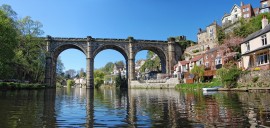Building societies: bouncing back to the future
Harrogate, where the Building Societies Association holds its annual conference, is located at the end of a branch railway line from York.
The route takes in the town of Knaresborough, crossing a picturesque gorge with a river at the bottom and the remains of a medieval castle up on the hill.
Arriving at the BSA conference venue the taxi driver observed, with a distinct sense of regret, that “there aren’t as many building societies around as there used to be.” That’s true: at the time of demutualisation in 1989 there were 110 building societies; today there are 46.
Vince Cable, business secretary for the UK government, described the demutualisation that began with Abbey National in 1989 as “one of the greatest acts of economic vandalism in modern times”. David Webster, chairman of the BSA, reminded delegates that all of the societies that demutualised have since either closed down or been bought up by competitors.
“History shows that the UK lost far more than it gained,” said Webster. “Not one of them remains independent today.”
Nevertheless, many of the traditional building societies still exist. Northern England seems to be their heartland; Barnsley, Cumberland, Darlington, Derbyshire, Doncaster, Manchester, Nottingham, Penrith, Skipton, Stockton and Tipton all have their own. The North and the Midlands boast 29 of the BSA’s 46 members, making up 63% of the total. The south of England has comparatively few, with only 11 societies (24%) located south of Northampton, while Wales, Northern Ireland and Scotland have two building societies each (13%).
In many ways, the Harrogate setting for BSA conference itself was a mirror to the building society sector as a whole. The main sessions took place in a recently restored Edwardian theatre, with paintings on the ceiling and lavish red furnishings that spoke of a long heritage; the press room is located in the bright white and green Royal Hall Bar, with plenty of natural sunlight. Despite this, delegates spent much of their time talking about modern challenges such as the rise of digital services – mobile banking apps, online mortgage applications – and the impact of those changes on the branch-based model. The exhibition hall was an interesting space, with a lively showing from various financial services providers and technology vendors.
Despite the challenges faced in recent years, it is clear that some building societies are fighting back against the high street banks. Nationwide, for example, has pledged to remain a mutual, and prides itself on its “on your side” motto, making full use of the fact that it is owned by members rather than shareholders. Nationwide currently has 15 million UK customers and a network of 800 branches – including one in Harrogate town centre.
Once again, aggressive use of modern technology plays a major role; Nationwide’s mobile banking app plainly offers far more than, for instance, HSBC’s equivalent, which merely allows users to check their balance.
Despite these signs of a fight-back, during a debate with representatives from the Financial Conduct Authority and Prudential Regulation Authority, BSA chief executive Adrian Coles brought up the the fact that there hasn’t been a new building society founded for a long time. (The Ecology Building Society set up in 1980 was the most recent.)
The problem is that because of intense capital requirements, a new society would have to hold enough funds for its first five years of operation from the outset. Coles suggested that one solution might be to encourage existing credit unions to become building societies, but Martin Stewart, responsible for banks and mutual at the PRA, said that more changes to the regulation would be needed to make that a possibility. Instead, he insisted that the PRA would apply its principle of lower capital requirements to both new banks and new building societies, easing the burden of the European Parliament’s CRD IV rules on potential start-ups.
It is promising that encouraging competition is one of the key tenets of the new regulators, though it remains to be seen if they will live up to that. If users voting with their feet is the driver, then the modern building society is surely a strong contender.
Roll on next year in Harrogate.












































